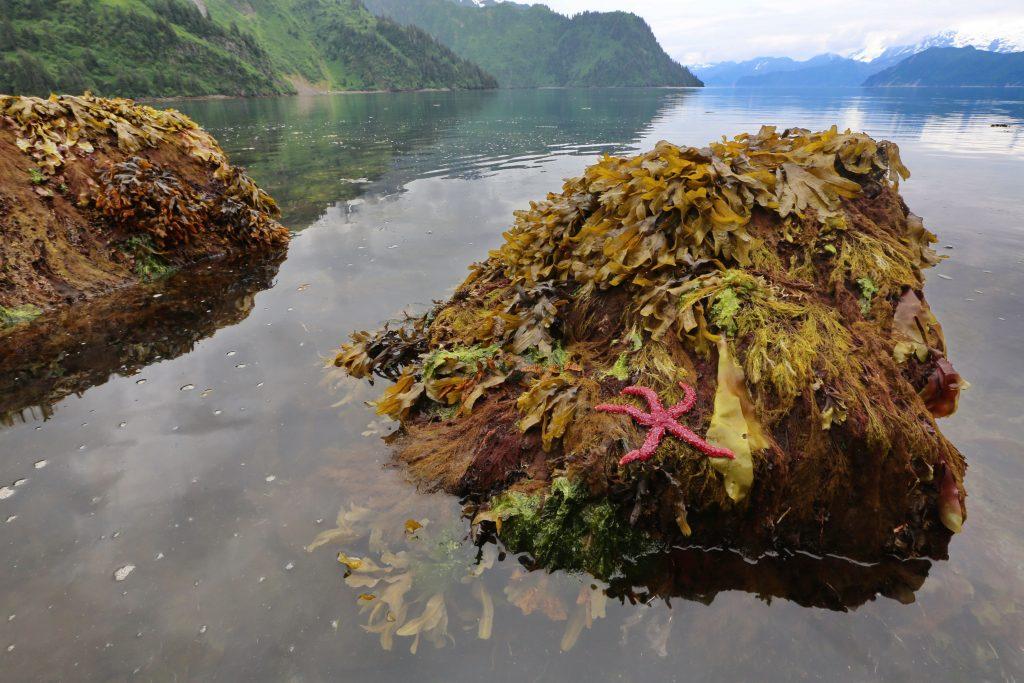Why are we sampling?
Rocky intertidal communities are well-studied relative to many other marine ecosystems. These communities are known to be responsive to a wide variety of factors that originate in both terrestrial and oceanic systems, including physical environmental conditions (see Intertidal Temperature), predation (see Sea Otter), competition, pollution, and development. Monitoring intertidal communities allows for a deeper understanding of the type and scale of factors that are influencing nearshore ecosystems.
Marine algae and sea grasses are the major primary producers in the nearshore and build the base of important food chains up to top consumers such as birds and sea otters. They are important components of intertidal communities, as they serve as nutrient filters and provide habitat for planktivorous fish, clams, and urchins, and a physical substrate for some invertebrates. Seaweeds also provide spawning and nursery habitats for forage fish and juvenile crustaceans.
Intertidal marine invertebrates serve a variety of roles in intertidal communities. They can be important competitors for space (e.g., barnacles and mussels). They also can be important consumers of marine algae (e.g., limpets and snails), and some species (e.g., sea stars and whelks) can be strong top-down predators of other invertebrates. Finally, invertebrates provide a critical prey resource for a variety of seabirds, marine mammals, fishes, and other invertebrates (e.g., octopus). They provide important sources of nutrients and energy to some terrestrial carnivores such as bears that seasonally forage in marine habitats, and are used by humans for subsistence and recreational harvest.
Where are we sampling?
We monitor intertidal communities across a broad swath of the northern Gulf of Alaska within the area affected by the Exxon Valdez oil spill including western Prince William Sound (WPWS), Kenai Fjords National Park (KEFJ), Kachemak Bay (KBAY), and Katmai National Park and Preserve (KATM).
How are we sampling?
We monitor the nearshore using a site-selection process that allows us to make statistical inference over spatial scales ranging from regional to site-specific, and to evaluate potential impacts of various factors at these different scales, included those resulting from human activities such as oil spills. Sampling includes annual recording of the percent cover of seaweed and invertebrate species along permanently established transects at different tide heights. We also conduct counts of mobile invertebrates (e.g., sea stars and snails) at each site.
What are we finding?
Since the onset of the marine heatwave in 2014, we have measured general decreases in seaweed cover, an indicator of primary production, although sampling in 2019 suggests communities in most of our regions are trending back toward pre-heatwave conditions. Rockweed (Fucus distichus) is known to cycle in abundance at local scales, but the recent large-scale declines across all regions are likely due to direct effects of warming on survival and recruitment. Changes in the abundance of Fucus are likely to have consequences for other dominant intertidal species because of the habitat this species provides for the associated community.

FIGURE 1. PERCENT COVER ANOMALIES (A DEVIATION FROM THE OVERALL MEAN) FOR ROCKWEED (FUCUS DISTICHUS) IN FOUR REGIONS OF THE NORTHERN GULF OF ALASKA.
As an important predator in structuring nearshore communities, sea star abundance is an important metric to track. Sea star abundance varied greatly among regions through 2015. In 2016, abundance began to decline due to sea star wasting syndrome and remained low across all regions during the marine heatwave, with trends toward potential recovery evident in some regions in 2019. However, in 2021, all regions except Katmai were again trending downward (Fig. 2). Preliminary analyses for 2023 also indicated that variability in species composition among regions has increased. Once dominant species are showing up less often, while species with previously low densities are more prevalent.





